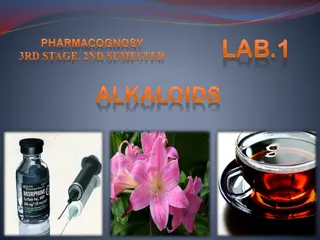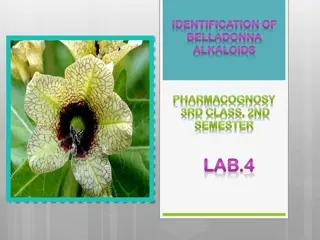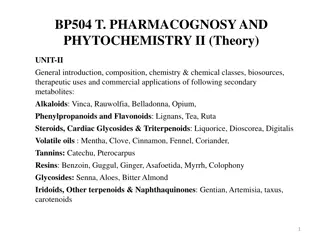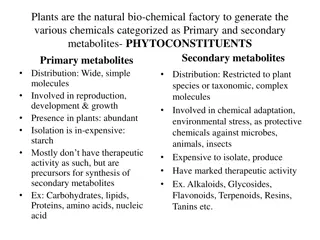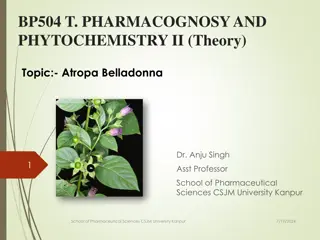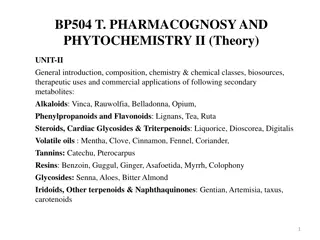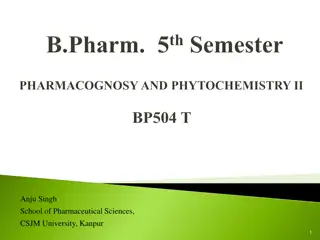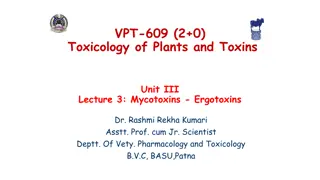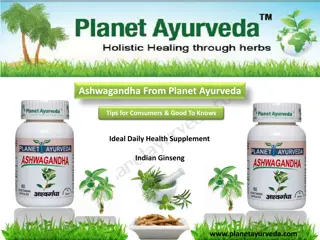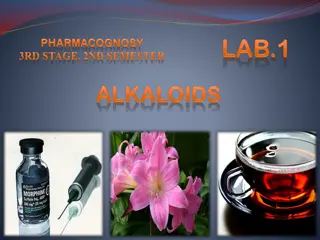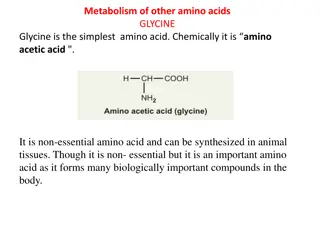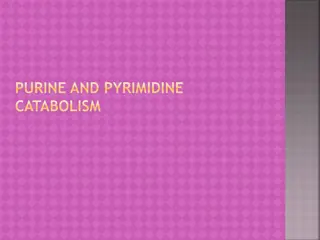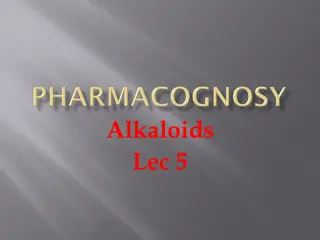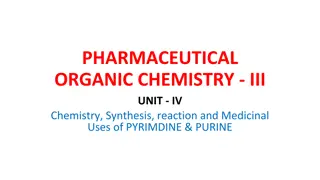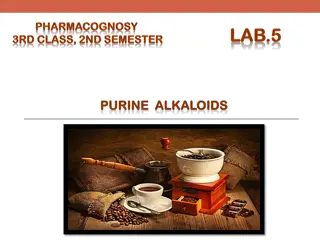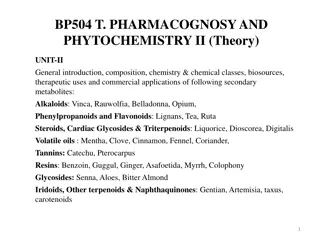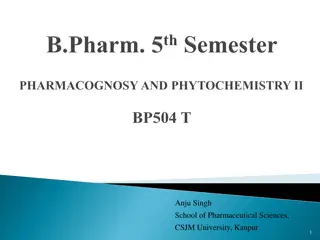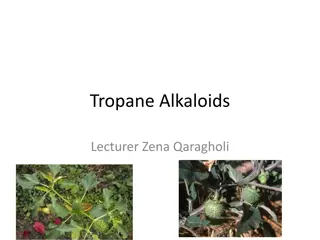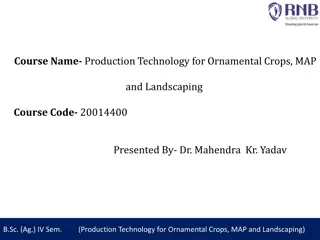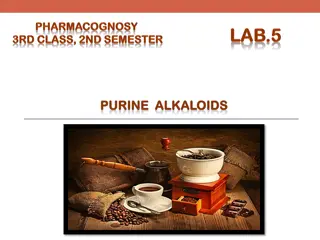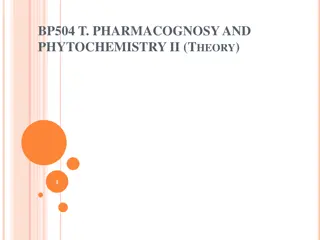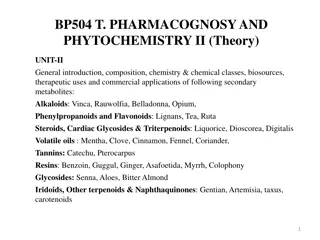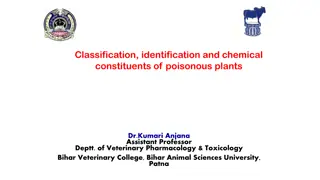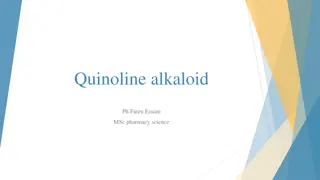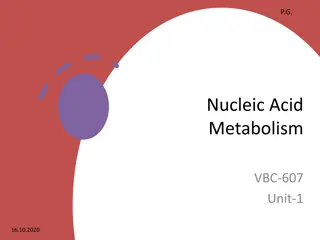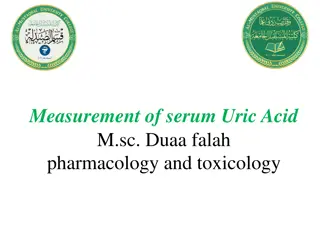FUNGAL SPECIES AND THEIR TOXINS.
Explore the world of fungal species and their toxins as studied by Prof. Abdullah Msaad Al-Falih at King Saud University's College of Science. Discover over 500 mycotoxins, including aflatoxins, ochratoxins, trichothecenes, fumonisins, sterigmatocystin, ergot alkaloids, zearalenone, Alternaria toxin
2 views • 8 slides
Understanding Alkaloids: Sources, Names, and Classification
Alkaloids, organic nitrogenous compounds of plant origin, are physiologically active and can contain elements like carbon, hydrogen, nitrogen, oxygen, sulfur, and more. They are found in various plant families such as Leguminosae, Papaveraceae, and Solanaceae. Alkaloids can be sourced from plants, a
3 views • 21 slides
Belladonna Alkaloids Identification Methods and Analysis
Learn about the qualitative and quantitative analysis methods for identifying belladonna alkaloids. Discover the differences between titration and back-titration, and follow a detailed procedure to quantitatively identify the alkaloids present. Equip yourself with the required equipment and reagents
0 views • 14 slides
Understanding Secondary Metabolites of Rue (Ruta graveolens)
Rue (Ruta graveolens) is a herb known for its medicinal properties and aromatic leaves. It contains various chemical constituents such as flavonoids, alkaloids, fixed oils, and volatile oils. The herb has a long history of traditional uses, including as an insect repellent and a condiment. Chemical
0 views • 10 slides
Understanding Plants: Primary Vs. Secondary Metabolites and Alkaloids
Plants act as natural bio-chemical factories producing primary and secondary metabolites with distinct roles in growth and adaptation. Primary metabolites are essential molecules like carbohydrates and proteins, while secondary metabolites like alkaloids have marked therapeutic activities. Alkaloids
0 views • 7 slides
Pharmacognosy and Phytochemistry II: Atropa Belladonna Overview
Atropa belladonna, commonly known as belladonna, is a plant rich in tropane alkaloids like atropine and scopolamine. This plant, belonging to the Solanaceae family, has various medicinal uses. Its distinct morphology and geographical sources make it a significant botanical specimen in pharmacognosy
0 views • 13 slides
Isolation and Analysis of Alkaloids: Atropine, Quinine, Reserpine, Caffeine
Alkaloids are extracted and isolated based on their basic character and solubility patterns using processes like Stas Otto. The general method includes treating plant material with solvents, extracting with ethanol, and separating bases using various techniques. Atropine, obtained from plants like A
2 views • 28 slides
Overview of Rauwolfia Alkaloids and Therapeutic Uses
Rauwolfia is a plant known for its alkaloids like Reserpine, Deserpine, and Ajmaline, with therapeutic applications in treating insanity and snake bites. These alkaloids are indole-based and occur in the roots of Rauwolfia plants. Reserpine, one of the major alkaloids, is a pale crystalline substanc
1 views • 13 slides
Overview of Secondary Metabolites: Alkaloids, Flavonoids, Steroids, and Glycosides
Exploring the diverse world of secondary metabolites, this content delves into the composition, chemistry, biosources, therapeutic uses, and commercial applications of various compounds such as Alkaloids, Flavonoids, Steroids, Glycosides, and more. It discusses the structural characteristics, biolog
0 views • 17 slides
Understanding Ergot Alkaloids: Toxicology of Plants and Toxins
Ergot alkaloids are toxins produced by parasitic fungi that invade cereal crops and grasses, leading to the formation of ergot. These toxins, including ergometrine and ergotamine, have various effects on the central nervous system, smooth muscles, and overall health. Ergotism, resulting from the ing
0 views • 14 slides
All About Ashwagandha: Benefits, Uses, and Properties
Ashwagandha, also known as Indian Ginseng, is a powerful herb with a wide range of health benefits. From reducing stress and anxiety to improving stamina and treating joint pains, Ashwagandha has been used in Ayurvedic medicine for centuries. With active constituents like alkaloids and steroidal lac
0 views • 15 slides
Overview of Alkaloids: Classification, Sources, and Characteristics
Alkaloids are organic nitrogenous compounds found in plants with physiological activity. They may also contain elements like oxygen, sulfur, chlorine, and phosphorus. Alkaloids can be sourced from plants, animals, bacteria, fungi, or industrial synthesis. Their names can be derived from plant names,
0 views • 19 slides
Overview of Glycine Metabolism and Its Importance in the Body
Glycine, the simplest amino acid, plays a crucial role in various metabolic pathways in the body. It can be converted to important compounds like pyruvic acid, lactic acid, and creates the one-carbon pool. Glycine is essential for heme synthesis, glutathione formation, purine synthesis, and more. In
8 views • 19 slides
Understanding Purine and Pyrimidine Metabolism in Genetic Disorders
Explore the intricate pathways of purine and pyrimidine catabolism, salvage, and degradation. Uncover the causes and symptoms of genetic disorders like Lesch-Nyhan Syndrome and Gout. Discover the importance of ribonucleotides conversion to deoxyribonucleotides in DNA synthesis. Dive into the mechani
0 views • 18 slides
Overview of Alkaloids in Pharmacology
Alkaloids are natural compounds found in various plants with diverse pharmacological properties. This lecture delves into alkaloids derived from sources like cinchona bark, discussing their structures, properties, and medical applications. It explores alkaloids such as quinine, quinidine, and ipecac
0 views • 17 slides
Chemistry, Synthesis, Reactions, and Medicinal Uses of Pyrimidine & Purine
Explore the fascinating world of pharmaceutical organic chemistry in Unit IV, focusing on the chemistry, synthesis, reactions, and medicinal applications of Pyrimidine and Purine compounds. Dive deep into the structures, properties, and pharmacological significance of these essential molecules throu
1 views • 15 slides
Understanding Purine Alkaloids and Their Pharmacological Activities
Purine alkaloids are a class of compounds with a unique structure, different from typical alkaloids. They include caffeine, theophylline, and theobromine, each with distinct effects on the body. These compounds are found in plants like coffee, tea, and cola, and have various pharmacological activiti
4 views • 15 slides
Overview of Indole Alkaloids in Pharmacognosy and Phytochemistry II
Indole alkaloids are a significant group of naturally occurring compounds with diverse chemical structures and physiological actions. This unit delves into the general introduction, composition, chemistry, biosources, therapeutic uses, and commercial applications of various secondary metabolites, in
0 views • 17 slides
Alkaloids and Heterocyclic Compounds: A Comprehensive Overview
Alkaloids are natural compounds containing nitrogen, with various pharmacological activities. Heterocyclic compounds, essential to life, include a diverse range of compounds such as alkaloids, antibiotics, and vitamins. The lecture delves into the properties, classifications, and examples of these c
12 views • 7 slides
Overview of Secondary Metabolites: Alkaloids, Glycosides, Flavonoids, and More
Secondary metabolites are chemical compounds produced by plants that have various biological effects. Alkaloids, a type of secondary metabolite, are organic compounds with nitrogen atoms and specific physiological actions. They exhibit diverse physical and chemical properties, making them essential
0 views • 63 slides
Exploring Secondary Metabolites in Ruta Graveolens for Therapeutic Applications
Delve into the world of secondary metabolites found in Ruta graveolens, commonly known as Rue or Garden Rue. Discover its rich composition of alkaloids, phenylpropanoids, flavonoids, steroids, cardiac glycosides, triterpenoids, volatile oils, tannins, resins, glycosides, iridoids, and other terpenoi
0 views • 13 slides
Understanding Datura Poisoning: Effects, Management, and Treatment
Datura, a genus of flowering plants, contains toxic alkaloids like scopolamine and atropine, causing severe symptoms ranging from dermatitis to hallucinations. Identifying datura seeds versus chili seeds, distinguishing signs of poisoning, managing fatal doses, and treatment methods like purgatives
0 views • 22 slides
Understanding Tropane Alkaloids in Datura Stramonium: Uses, Risks, and Chemistry
Datura stramonium, commonly known as Jimson weed, contains tropane alkaloids like atropine and scopolamine. These alkaloids have medicinal uses but can also be fatal if consumed in high amounts. The plant has been historically used for asthma relief and as a hallucinogen, but its toxicity can lead t
0 views • 22 slides
Production Technology of Periwinkle - Medicinal Plant Cultivation Guide
Learn about the production technology of periwinkle, a perennial ornamental herb with medicinal properties. Understand its botanical details, uses in treating diseases, cultivation requirements such as soil and climate preferences, and its significance in pharmaceuticals. Discover the various alkalo
0 views • 10 slides
Understanding Purine Alkaloids: Properties, Isolation, and Pharmacological Activities
Purine alkaloids are a group of compounds with unique characteristics, such as a heterocyclic nucleus and specific methylated forms like caffeine, theophylline, and theobromine. While they have diverse pharmacological activities like CNS stimulation and diuretic effects, their identification often i
0 views • 16 slides
Understanding Purine Degradation and Gout
Purine degradation pathway involves the breakdown of dietary nucleic acids, mainly from meat, into uric acid through specific enzymatic steps. Excessive uric acid production can lead to conditions like gout and hyperuricemia. Humans excrete uric acid in the urine as the final product, while other an
0 views • 12 slides
Understanding Chemotaxonomy: Classification of Plants Based on Chemical Constituents
Chemotaxonomy, presented by Dr. R. P. Patil, explores the scientific investigation of the chemical characters in plants for taxonomy and phylogeny studies. It involves classifying plants based on their chemical constituents and molecular characteristics. Principles, methods, and importance of chemot
0 views • 24 slides
In-depth Study of Indole Alkaloids: Vinca, Rauwolfia, and Its Derivatives
Explore the world of indole alkaloids through a detailed examination of Vinca and Rauwolfia plants, their chemical structures, distribution, physiological actions, and commercial significance. Uncover the history of indole discovery, its versatile derivatives, and the essential role it plays in vari
0 views • 18 slides
Overview of Alkaloids in Pharmacognosy
Alkaloids are a diverse group of compounds containing nitrogen that are derived from amino acids like phenylalanine or tyrosine. Protoalkaloids, such as ephedrine, are derived from common amino acids and do not contain a heterocyclic ring. Ephedrine, obtained from Ephedra sinica, has CNS stimulatory
0 views • 11 slides
Exploration of Tropane Alkaloids: Atropine, Scopolamine, and More
Tropane alkaloids are a diverse group of secondary metabolites found in plants like Atropa belladona and Datura stramonium. Known for their medicinal properties, these alkaloids have notable therapeutic uses and can be chemically classified based on their structures and biosources. Atropine and scop
0 views • 10 slides
Overview of Poisonous Plants: Classification, Identification, and Toxic Chemical Constituents
This detailed chapter delves into the classification, identification, and chemical constituents of poisonous plants, shedding light on natural toxins, alkaloids, and toxic principles. It covers the role of alkaloids in plant toxicity, highlighting specific types such as piperidine alkaloids, pyrroli
0 views • 17 slides
Understanding Quinoline Alkaloids in Ruta graveolens for Medicinal Purposes
Ruta graveolens, commonly known as Rue, contains quinoline alkaloids and other active constituents with medicinal properties. This plant is used in the treatment of various inflammatory conditions, ulcers, arthritis, and more. However, there are cautionary notes for specific groups such as pregnant
0 views • 14 slides
Understanding Purine Nucleotide Synthesis in Molecular Biology
The process of Purine Nucleotide Synthesis involves the formation of purine ribonucleotides, breakdown into uric acid, and the detailed steps of purine nucleotide synthesis. Key components like IMP, SAICAR, PRPP, and ATP play crucial roles in this complex metabolic pathway, offering insights into th
0 views • 22 slides
Exploring the World of Nucleotides and Nucleic Acids
Discover the fascinating realm of nucleotides and nucleic acids through characteristic bases, pentoses, tautomeric forms of common pyrimidine and purine bases, electron-rich nature, UV absorption spectra, furanose structures, major and minor bases, nucleosides, and phosphodiester bonds linking succe
0 views • 26 slides
Understanding Serum Uric Acid Levels and Hyperuricemia
Serum uric acid is a crucial marker of purine metabolism, with elevated levels indicating hyperuricemia which can lead to conditions like Gout. The measurement of serum uric acid helps in diagnosing hyperuricemia, with serum being the preferred specimen for testing. Various factors such as diet, gen
0 views • 12 slides

